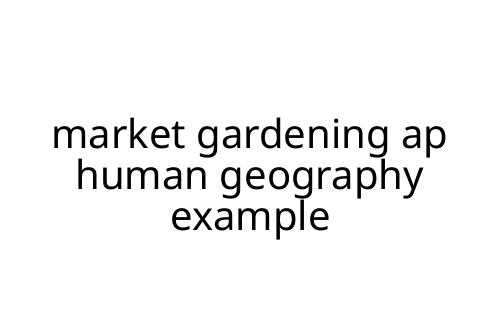market gardening ap human geography example
Market gardening is a key topic in AP Human Geography, especially when exploring agricultural patterns and rural land use. If you’re looking for a clear market gardening AP Human Geography example, this article breaks it down with straightforward explanations, practical observations, and some honest pros and cons.
What Is Market Gardening?
Market gardening refers to the small-scale production of fruits, vegetables, and flowers, typically sold directly to local consumers, restaurants, or markets. Unlike large-scale commercial farming, market gardens focus on producing a variety of crops across small plots. The hallmark is diversity and proximity to customers.
Why Does Market Gardening Matter in AP Human Geography?
Market gardening helps illustrate core concepts like intensive vs. extensive agriculture, land use near urban areas, and the impact of transportation costs on crop selection. As part of the Von Thünen model—one of the major theories studied in AP Human Geography—market gardening represents a classic example of farming close to a city center due to the perishable nature of the crops and the need for quick transport.
Classic Example: Philadelphia’s Greater Area
A textbook market gardening AP Human Geography example is found just outside Philadelphia. Farmers on the city’s suburban fringe grow lettuce, tomatoes, and herbs on small parcels, delivering produce to city markets daily. This matches Von Thünen’s model: high-value, perishable crops are farmed near urban hubs where land is pricier but access to consumers is immediate.
Characteristics of Market Gardening
- Location: Near urban centers for quick delivery
- Crops: High value, often perishable—think salad greens, strawberries, fresh flowers
- Farming Scale: Small, intensively managed plots
- Labor: Labor-intensive, often involving families or small crews
- Distribution: Direct sale to local buyers or specialty grocers
Pros and Cons
Pros:
- Reduces food miles (distance from farm to consumer)
- Supports local economies
- Offers fresher produce with more variety
- Adaptive: growers can quickly change crops to match demand
Cons:
- Vulnerability to urban sprawl (cities expanding into farmland)
- Relatively high labor costs
- Exposed to risks from rapid market shifts or weather events
- Competition with larger agribusinesses for land and water
How Market Gardening Fits in AP Human Geography
Understanding market gardening is important for AP Human Geography students. It demonstrates how distance from markets shapes agricultural practices and ties to the Von Thünen model—a core exam concept. Students are often asked to provide a market gardening AP Human Geography example like those on the edge of New York City, Chicago, or European cities, where farmers cluster around urban areas to maximize freshness and minimize delivery times.
Practical Tip for Studying
When preparing for the AP exam, link market gardening to concepts like urban sprawl, transportation costs, and the difference between subsistence and commercial farming. Use real-world examples from your area if possible. Always tie back to the models and key terms in your answers.
Summary
A solid market gardening AP Human Geography example is a suburban farm producing vegetables for local city markets. It’s intensive, diverse, and offers a clear case of how geography shapes agriculture. By understanding these real applications, you’ll be better prepared to tackle both exam questions and broader agricultural topics.

 Christyn Stearnsio, the visionary founder of Sculpture Creation Tips, is a passionate artist with a deep love for the art of sculpting. With years of experience in the field, Christyn has dedicated her career to sharing her knowledge and expertise with others, creating a platform that serves as a comprehensive guide for sculptors at all levels. Sculpture Creation Tips is a testament to her commitment to nurturing creativity and helping artists master the delicate craft of sculpting. Through detailed tutorials, insightful articles, and a supportive community, Christyn empowers aspiring sculptors to explore their artistic potential, refine their skills, and bring their unique visions to life. Her dedication to the art form is evident in every piece of advice and inspiration she shares, making Sculpture Creation Tips a trusted resource for sculptors around the world.
Christyn Stearnsio, the visionary founder of Sculpture Creation Tips, is a passionate artist with a deep love for the art of sculpting. With years of experience in the field, Christyn has dedicated her career to sharing her knowledge and expertise with others, creating a platform that serves as a comprehensive guide for sculptors at all levels. Sculpture Creation Tips is a testament to her commitment to nurturing creativity and helping artists master the delicate craft of sculpting. Through detailed tutorials, insightful articles, and a supportive community, Christyn empowers aspiring sculptors to explore their artistic potential, refine their skills, and bring their unique visions to life. Her dedication to the art form is evident in every piece of advice and inspiration she shares, making Sculpture Creation Tips a trusted resource for sculptors around the world.
